Turning disused buildings into artist studios
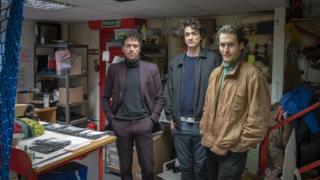
Musician Ollie Tobin, artist Josh Field and writer Roland Fischer-Vousden founded SET to provide artists with workspaces in London
Rising rents are seeing artists priced out of major cities, but now landlords are turning to them to help protect commercial properties from squatters.
Twenty-seven-year-olds Josh Field and Ollie Tobin, and Roland Fischer-Vousden, 28, are school friends with a passion for the arts.
In 2014, just before completing their undergraduate degrees in London, they realised that they would struggle to realise their dreams of becoming working creatives, because there was nowhere for them to work.
The creation of large-scale art pieces and music often requires space, industrial tools and the freedom to make a lot of noise.
None of these things are possible at urban residential properties, and studio space is very expensive.
“Art school doesn’t prepare you for the real world, and we were trying to find some sort of loophole where we could get affordable vacant space in London,” Josh says.
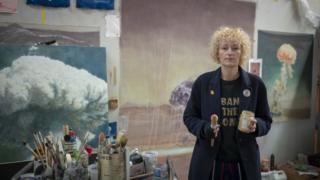
Artist Kirsty Harris at her studio in a SET building in Bermondsey, south-east London

Kirsty says a studio is so valuable that she would rather go without material things in order to afford the space
Seeing the concept of property guardianship become popular in London – where people pay low rent to live in and look after vacant buildings – the trio began contacting property developers.
Within two years, their hard work paid off, and in September 2016, they founded a non-profit called SET.
SET offers workspaces to painters, musicians, sculptors, graphic designers, metalworkers, interactive artists and fashion designers.
They were able to lease their first building in east London, and 50 artists snapped up the available spaces within three weeks.

Madeleine Pledge and Eva Gold prepare an exhibition entitled The Dwelling at SET
Today, SET has rented seven buildings in two years, including a Victorian pub, a book-packing warehouse, a Grade II listed Victorian train station, high-rise office buildings and commercial properties.
Their project has helped artists like Richard Gasper, Kira Freije, Sam Austen and Hazel Brill, who have exhibited work at some of London’s top galleries.
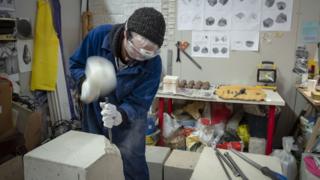
Sculptor Henrietta Armstrong at work in her studio at SET
“It’s somewhere you can escape to. I’m a lot more productive if I’ve got a space and it’s away from my house,” says artist Kirsty Harris, 40.
She stresses that all artists want to have both a home and a studio, and will often compromise on material things in order to afford both.
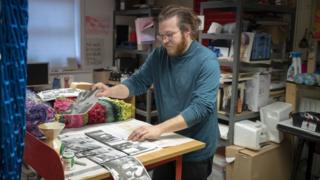
Printer Jordan Taylor says the shared workspace offers more freedom and a community of like-minded people to collaborate creatively with
“There’s no-one looking over your shoulder,” says 28-year-old Jordan Taylor, an artist and co-owner of eco-printing press start-up PageMasters, who has been with SET for two years.
“SET is a much more autonomous place than anywhere I’ve been before.
“There’s also a lot of benefit in having access to a community. It’s good for collaborating, making contacts and getting more work.”
How it works
Vacant properties are subject to business rates, but these are reduced if a non-profit uses the property.
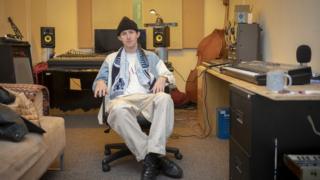
Music producer Warmthness in his soundproofed studio at SET in Bermondsey
The landlord and SET enter into a temporary “meanwhile” lease. The property is leased rent-free, with the non-profit agreeing to cover business rates, utility bills, building insurance, ground rent and service charge.
Leases typically last only six months, or are rolling month-to-month.
The artists often don’t know when they’ll be asked to leave, which can be stressful and interrupt their work, but they say it beats having nowhere to work at all.
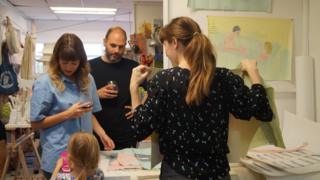
Image copyright
SET
Families visiting a SET Open Studios event day in Dalston
“The landlords are getting free security. We’re competitive to other guardianship companies because we can use buildings that are not suitable as living spaces, including semi-derelict properties,” says Josh Field.
SET converts vacant buildings into safe, usable space by adding amenities like lighting, heating and basic security, as well as erecting walls for studios.
Interested artists apply to become members of SET, and their monthly membership fees are used to pay the bills.
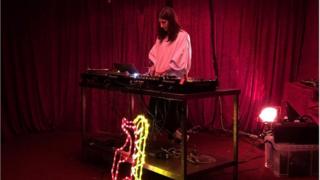
Image copyright
SET
Kitty Clark performing at SET’s Bar in Dalston. The bar provides a source of income and helps to promote musicians
In addition to giving artists workspace, the public is encouraged to visit and participate in free workshops, as a way to give back to the local community.
Helping artists
SET is the first concept of its kind in London, but it is based on a similar model from Leeds.
In 1993, artists Karen Watson and John Wakeman were looking for a space to work.
They gathered a large group of artists to form East Street Arts (ESA), and applied for funding through Arts Council England.
This enabled them to purchase a building in Leeds city centre, which they turned into Patrick Studios.
ESA was founded with the aim of promoting artists and getting them paid opportunities.
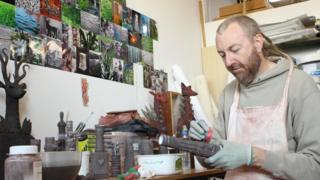
Image copyright
Natalie Whitney/East Street Arts
Artist Drew Caines working at East Street Arts’ Patrick Studios in Leeds
As part of that, the non-profit tries to generate its own income, such as running an arts-themed hostel in Leeds.
Today, it also offers funding for PhDs at Sheffield University into developing housing for artists, and it recently launched a four-year programme called Guild, which provides training to help artists learn financial planning and how to run a business.
“We’re trying to make artist groups have more of a business focus. A lot of groups have problems securing space, dealing with landlords and councils,” Gaynor Seville, strategic manager of ESA’s Guild programme, explains.
“To do that we need to help them develop skills you wouldn’t ordinarily associate with artists.”
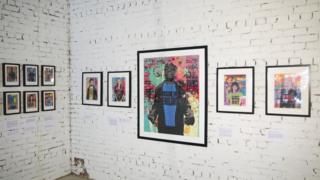
Image copyright
Tony Baker/East Street Arts
An exhibition at Leeds City College, featuring work by artists from East Street Arts
ESA also helped another non-profit, Castlefield Gallery, to get started in Manchester, where gentrification has eradicated almost all artist workspaces.
Regenerating areas
Back in London, Southwark Council has had its own team working with the private sector to secure working spaces for artists since 2010.
Its regeneration efforts also involve bringing disused buildings back into use.
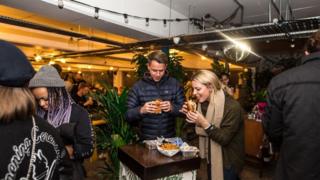
Image copyright
Southwark Council
People enjoying street food at a food court in Peckham Levels
“Artists have a great way of bringing buildings back in the heart of the community, by working with schools and community organisations,” says Labour’s Johnson Situ, Southwark councillor for the ward of Peckham.
“The council doesn’t engage in these leases to make a profit. The leases more gear towards us being able to see a social impact.”
Although the council does seek to make money from commercial properties, it found that temporary leases led to long-lasting social benefits in urban areas.
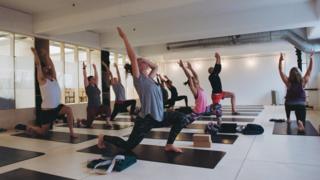
Image copyright
Southwark Council
People take classes at Peckham Levels’ yoga studio
One of the council’s biggest successes is Peckham Levels, a disused multi-storey car park that was once a concrete eyesore.
Today, it offers shops, restaurants, artist workspaces and a place for local start-ups to build their businesses and offer apprenticeships to young adults.
Outset, a foundation that supports contemporary art, is also trying to help artists by convincing property developers to incorporate artist workspaces at a discounted rent into new residential developments and shopping malls.

Image copyright
Southwark Council
The Ramp in Peckham Levels is a creative co-working space for start-ups and freelancers
“It creates a better environment for your other tenants,” says Outset’s project director Yves Blais.
“There’s a reason why Central St Martins moved into Granary Square behind King’s Cross Station – it was to attract other tenants, like Google.”
Criticism
However, Andrew Teacher, a former spokesperson for the property industry who once dreamed of being a musician, questions councils’ decisions to give these temporary leases to artists.
“A lot of old buildings aren’t safe and aren’t suited for these purposes. If you’re an artist going in using various tools, you need safety procedures to prevent fire hazards, and there’s a question about how these safety procedures are maintained,” he says.
“Why are artists only useful when we can’t rent out a building?”
He wants to see councils take out compulsory orders to purchase pieces of land, and then subsidise the rent on properties for artists.
“Just as nurses shouldn’t have to go to food banks, artists shouldn’t have to scrabble around.”
BBC photos by Phil Coomes. All photographs subject to copyright.

